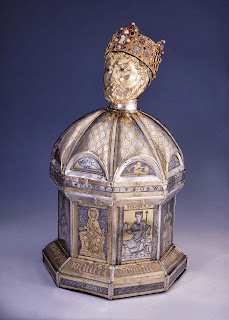Van Gogh Repetitions
Phillips Collection, Washington, D.C., Oct. 12, 2013–Jan. 26, 2014
Reviewed by Ed Voves
Van Gogh Repetitions, on view at the Phillips Collection in Washington D.C., explores the great Dutch artist's habit of painting multiple versions of a select group of people, places and things. But this intelligently curated exhibit is much more than a presentation of theme and variations.
Vincent van Gogh (1853-1890) possessed the eye of a discoverer. Van Gogh looked searchingly at both the mundane facts of human life and the cosmic scope of creation. While van Gogh painted singular, prophetic works like Starry Night, he also worked and reworked depictions of more prosaic images. This was a different sort of endeavor from Claude Monet's evocations of Rouen Cathedral. Van Gogh returned to the same sets of images in order to grapple with more than just the effects of light. He probed humanity's interaction with nature. He addressed the meaning of time itself.
The Bedroom at Arles
How strange these last three months appear to me. Sometimes nameless moral anguish, then moments when the veil of time and of the inevitability of circumstances seemed to open up a little way for the space of a blink of an eye.
In the "blink of an eye" during the late autumn of 1888, van Gogh painted Madame Augustine Roulin, holding her baby girl, Marcelle. Madam Roulin was the wife of his friend, Joseph Roulin, the postman of the town in the south of France, Arles, where van Gogh had gone to establish the "Studio of the South." This wonderful painting, in the collection of the Philadelphia Museum of Art, is on display in the van Gogh exhibit at the Phillips. A noteworthy work of art in its own right, Portrait of Madame Augustine Roulin and Baby Marcelle served as the foundation of five extraordinary "repetitions" on the theme of motherhood.
Van Gogh used the expression "La Berceuse" in the titles of these paintings. This may be translated as lullaby, a word and an image with major cultural implications during the Victorian era. Frederick Chopin composed a major work on this theme in 1844, the lyrical masterpiece, Berceuse (Lullaby) in D flat major, Op.57. Two decades later, the American poet William Ross Wallace, a close friend of Edgar Allen Poe, wrote a hugely popular poem extolling the influence of motherhood. This poem is now commonly known by its refrain:
For the hand that rocks the cradle
Is the hand that rules the world.
Such expressions of maternal care, however, are not readily apparent in van Gogh's La Berceuse paintings.
Madame Roulin's expression in these five portraits ranges from apprehension and stress to philosophical resignation. Also, she looks considerably older in these five repetitions than in the slightly earlier Philadelphia Museum portrait. It is known that Madame Roulin was becoming alarmed at van Gogh's emotional state by the time he started working on the first of the series in December 1888. Madame Roulin's fears for van Gogh's sanity may be reflected in these paintings.
Van Gogh painted portraits of all the members of the Roulin family during this period. He felt a real bond of affection for the family. Even chubby cheeked little Marcelle was recorded for posterity by van Gogh in an individual portrait.
Portrait of Baby Marcelle Roulin
Joseph Roulin, the paterfamilias, brought van Gogh his mail and helped smooth his often stormy relations with other citizens of Arles. Pere Roulin was painted in a series of portraits similar to those of his wife. The paintings are remarkable for the flowering backgrounds and the variations in the way that Roulin's personality is explored. Husband and wife thus receive the same vivid treatment by van Gogh. But there is a lot more going on in the La Berceuse series.
When we look at these 'lullaby" pictures the absence of the infant is immediately apparent. Baby Marcelle's presence is implied by the rope that Madame Roulin is clutching in her hand. By gently pulling on this rope, Madame Roulin could rock Marcelle's cradle while singing the baby to sleep.
The rope, however, has gone slack. If little Marcelle is assumed to be in the cradle, Madame Roulin is not viewed from the position of an infant looking upward. Instead she is seen from the eye level of an adult. She looks away from this mature viewer and is clearly not in the mood for singing a lullaby.
When we look at these 'lullaby" pictures the absence of the infant is immediately apparent. Baby Marcelle's presence is implied by the rope that Madame Roulin is clutching in her hand. By gently pulling on this rope, Madame Roulin could rock Marcelle's cradle while singing the baby to sleep.
The rope, however, has gone slack. If little Marcelle is assumed to be in the cradle, Madame Roulin is not viewed from the position of an infant looking upward. Instead she is seen from the eye level of an adult. She looks away from this mature viewer and is clearly not in the mood for singing a lullaby.
Madame Augustine Roulin Rocking a Cradle (La Berceuse)
Van Gogh had painted a portrait of his mother in October 1888, based on a photograph sent from Holland. This broadly smiling depiction of his mother is one of van Gogh's least convincing works. Were the La Berceuse paintings a way for van Gogh to confront and deal with his ambivalent feelings towards his mother? In these paintings, was van Gogh confronting the woman who had given him life, only to withhold the affection and regard he so desperately craved?
Van Gogh's paintings and the perceptive commentary he often addressed to Theo reveal a firm grasp of reality, at least in terms of what he painted.
Lullaby: Madame Augustine Roulin Rocking a Cradle (La Berceuse)
Van Gogh expounded on the fifth in the La Berceuse series, the one in the collection of the Boston Museum of Fine Arts, as "nothing but a chromolithograph from a penny bazaar." But then he astutely noted that his aim was to "to make an image such as a sailor who couldn’t paint would imagine it when he was in the middle of the sea and thought of a woman on land."
Van Gogh's aim with his répétitions was to evoke the world around him as the peasants and townsfolk of Arles saw it, as the sailors at sea imagined it. And if these images, as he noted to Theo, did not "even have the merit of being photographically correct," then a valid sense of reality would be produced by intense searching and repeated depiction.
The exhibition at the Phillips Collection is instrumental in enabling art lovers to grasp the "working artist" van Gogh instead of the tortured genius van Gogh. And this is as true for van Gogh in his landscapes and genre studies as when he painted portraits.
Entrance to the Public Gardens at Arles
The Large Plane Trees (Road Menders at Saint-Rémy)
Entrance to the Public Gardens at Arles is a brilliant example of the way that van Gogh integrated human figures in their natural surroundings. The same is true of two street scenes painted in Saint-Rémy during the autumn of 1889. Both are on view in the Phillips exhibit. In The Large Plane Trees, from The Cleveland Museum of Art, and the Phillips Collection's The Road Menders, van Gogh aimed - and succeeded - in capturing the living essence of village life. Van Gogh rooted real people, as well as towering trees, in the soil of the south of France.
The Road Menders
However similar The Road Menders and The Large Plane Trees may appear, the two works are unique statements of the changing patterns of daily life. These two paintings are not the same work, with different titles and different color schemes. Life is not static and van Gogh's répétitions are anything but repetitious.This carefully focused exhibition at the Phillips Collection provides a much needed reprieve from the endless psycho-analysis applied to van Gogh's paintings. By emphasizing the technique van Gogh used to create his art, the exhibit enables us to appreciate his beautifully expressed conviction that in "filling one’s canvas regardless . . . one catches the true and the essential."
***
Text: Copyright of Ed Voves, all rights reserved
Images courtesy of the Phillips Collection, Washington D.C.
Introductory Image:
Portrait of Joseph Roulin April 1889 Oil on canvas 25 1/2 x 21 1/4 in. Collection Kröller-Müller Museum, Otterlo
The Bedroom at Arles October 1889 Oil on canvas 22 11/16 x 29 1/8 in. Musée d’Orsay, Paris
Portrait of Baby Marcelle Roulin December 1888 Oil on canvas 13 3/4 x 9 3/4 in. Van Gogh Museum, Amsterdam
Madame Roulin Rocking the Cradle (La Berceuse) February 1889 Oil on canvas 36 1/2 x 29 1/2 in. Art Institute of Chicago Helen Birch Bartlett Memorial Collection
Lullaby: Madame Augustine Roulin Rocking a Cradle (La Berceuse) February–March 1889 Oil on canvas 36 1/2 x 28 5/8 in. Museum of Fine Arts, Boston Bequest of John T. Spaulding
Entrance to the Public Gardens at Arles 1888 Oil on canvas 28 1/2 x 35 3/4 in. The Phillips Collection, Washington, DC Acquired 1930
The Large Plane Trees (Road Menders at Saint-Rémy) November–December 1889 Oil on commercially printed fabric 28 7/8 x 36 1/8 in. The Cleveland Museum of Art Gift of the Hanna Fund
The Road Menders November–December 1889 Oil on canvas 29 x 36 1/2 in. The Phillips Collection, Washington, DC Acquired 1949
+The+Postman+Joseph+Roulin,+February_March+1889,+Collection+Kr%C3%B6ller-M%C3%BCller+Museum,+Otterlo.jpg)
+Van+Gogh_s+Bedroom+in+Arles,+1889,+Mus%C3%A9e+d_Orsay,+Paris.jpg)
+Portrait+of+Marcelle+Roulin,+1888,+Van+Gogh+Museum,+Amsterdam.jpg)
+Madame+Roulin+Rocking+the+Cradle+(La+Berceuse),+1889,+The+Art+Institute+of+Chicago.jpg)
+Lullaby+Madame+Augustine+Roulin+Rocking+a+Cradle+(La+Berceuse),+1889,+Museum+of+Fine+Arts,+Boston.jpg)
+Entrance+to+the+Public+Gardens+in+Arles,+1888,+The+Phillips+Collection.jpg)
+The+Large+Plane+Trees+(Road+Menders+at+Saint-R%C3%A9my),+1889,+The+Cleveland+Museum+of+Art.jpg)
+The+Road+Menders,+1889,+The+Phillips+Collection.jpg)















